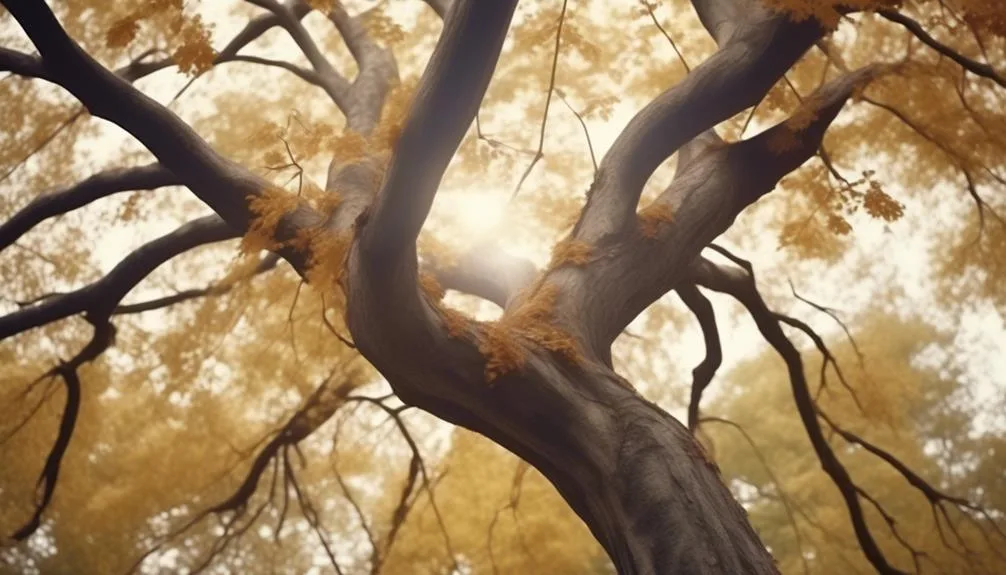Are Hickory Trees Vulnerable to Strong Winds?
Hickory trees may seem strong, but they're not immune to damage from powerful winds. Before imagining the worst, let's understand the real impact.
Knowing how strong winds affect hickory trees and how to protect and restore them is vital for tree lovers. Stay tuned to learn about how these majestic trees withstand nature's fury.
Hickory Trees and Wind Damage
If you live in an area prone to strong winds, hickory trees can be particularly vulnerable to wind damage due to their tall, straight trunks and dense canopies. Proper tree maintenance is crucial in enhancing the wind resistance of hickory trees.
Regular pruning can help reduce the weight and density of the canopy, making it less susceptible to wind damage. Additionally, removing any dead or weak branches can prevent them from becoming projectiles during strong winds.
Ensuring that the tree has a healthy root system and is properly anchored in the ground is also essential in boosting its wind resistance.
Impact of Strong Winds on Hickory Trees
Hickory trees, particularly vulnerable to wind damage due to their tall, straight trunks and dense canopies, can suffer significant impact from strong winds. When facing strong winds, hickory trees exhibit remarkable resilience and wind resistance, but they aren't impervious to damage.
The impact of strong winds on hickory trees includes:
- Branch Breakage: Strong winds can cause the snapping of branches, especially in older, weaker branches.
- Upheaval: The force of strong winds can lead to the uprooting of hickory trees, particularly if the soil is saturated or shallow-rooted.
- Canopy Damage: The dense canopy of hickory trees can be thinned out or damaged by strong winds, affecting the tree's photosynthetic capacity.
- Trunk Snapping: In extreme cases, the trunk of a hickory tree can snap under the force of strong winds.
Understanding the impact of strong winds on hickory trees is crucial for effective management and conservation efforts.
Signs of Wind Damage on Hickory Trees
When inspecting hickory trees for wind damage, look for telltale signs such as broken branches, thinning canopies, and uprooted soil around the base of the tree.
Broken branches are a clear indicator of wind damage, especially if they're large or numerous.
Thinning canopies, where the foliage appears sparse or uneven, may suggest that the tree has been stressed by strong winds.
Additionally, uprooted soil around the base of the tree signifies that the roots have been compromised, potentially by powerful gusts.
Recognizing these signs is crucial for assessing the impact of wind on hickory trees and determining the appropriate tree care measures.
Furthermore, understanding the wind resistance of hickory trees and taking steps to promote their overall health can help minimize the risk of wind damage and enhance the resilience of these magnificent trees.
Protecting Hickory Trees From Strong Winds
To protect your hickory trees from strong winds, it's essential to implement proactive measures that strengthen their resilience and minimize potential damage. Here are some effective strategies to safeguard your hickory trees:
- Protecting roots: Ensure the soil around the base of the tree is well-mulched and compacted to provide stability and support to the roots.
- Wind breakers: Planting wind-resistant shrubs or erecting fences can create a barrier that reduces the impact of strong winds on your hickory trees.
- Pruning: Regularly trim the branches to remove weak or overextended limbs that are susceptible to wind damage.
- Cabling and bracing: Professional installation of cables and braces can provide additional support to the tree's structure, reducing the risk of damage during high winds.
Restoring Wind-Damaged Hickory Trees
After enduring strong winds, your hickory trees may require careful restoration to promote their recovery and ensure their future health and vitality.
Start by assessing the extent of the damage. Look for broken branches, split bark, or uprooted trees.
Prune broken branches cleanly to prevent further tearing and disease. For split bark, gently reposition the bark and use tree wound dressing to aid healing.
Uprooted trees should be carefully repositioned and supported with stakes.
Adequate watering and mulching can aid in the recovery process. Keep an eye out for signs of stress such as wilting or yellowing leaves, and consider consulting a professional arborist for further guidance.
To prevent wind damage in the future, consider planting windbreaks or installing supportive cables for weak branches.
Conclusion
To safeguard hickory trees from wind damage, proactive measures like proper pruning and staking are crucial. By nurturing their resilience, we can ensure these trees endure and enrich our landscapes.
How can we best support the natural strength of hickory trees for the long term?
Mark Hoffman is a dedicated arborist and tree care specialist with over a decade of experience. His love for trees began when he visited Yosemite National Park as a teenager and was awestruck by the giant sequoias. Mark pursued his passion by studying forestry at Michigan Technological University, where he earned a Bachelor of Science degree.
Since then, he has worked tirelessly in the field of arboriculture, helping to preserve and protect trees in his community. His expertise and dedication have made him a respected leader in the industry and a valuable resource for anyone seeking advice on tree care.
